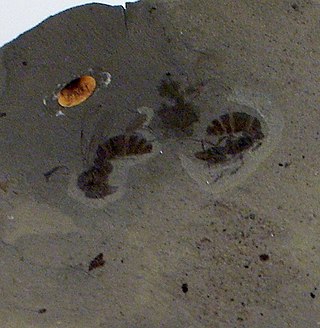
Ypresiomyrma is an extinct genus of ants in the subfamily Myrmeciinae that was described in 2006. There are four species described; one species is from the Isle of Fur in Denmark, two are from the McAbee Fossil Beds in British Columbia, Canada, and the fourth from the Bol’shaya Svetlovodnaya fossil site in Russia. The queens of this genus are large, the mandibles are elongated and the eyes are well developed; a stinger is also present. The behaviour of these ants would have been similar to that of extant Myrmeciinae ants, such as solitary foraging for arthropod prey and never leaving pheromone trails. The alates were poor flyers due to their size, and birds and animals most likely preyed on these ants. Ypresiomyrma is not assigned to any tribe, and is instead generally regarded as incertae sedis within Myrmeciinae. However, some authors believe Ypresiomyrma should be assigned as incertae sedis within Formicidae.

Archimyrmex is an extinct genus of ant in the formicid subfamily Myrmeciinae, described by palaeoentomologist Theodore Cockerell in 1923. The genus contains four described species, Archimyrmex rostratus, Archimyrmex piatnitzkyi, Archimyrmex smekali and Archimyrmex wedmannae. Archimyrmex is known from a group of Middle Eocene fossils which were found in North America, South America, and Europe. The genus was initially placed in the subfamily Ponerinae, but it was later placed in Myrmeciinae; it is now believed to be the ancestor of the extant primitive genus Myrmecia from Australia. Despite this, Archimyrmex is not a member to any tribe and is regarded as incertae sedis within Myrmeciinae. However, some authors believe Archimyrmex should be assigned as incertae sedis within Formicidae. These ants can be characterised by their large mandibles and body length, ranging from 13.2 to 30 mm. They also have long, thin legs and an elongated mesosoma (thorax) and petiole.

Emplastus is an extinct morphogenus of ants in the subfamily Dolichoderinae, known from fossils found in Asia and Europe. The genus contains twelve species described from sites in England, Eastern Europe and Far Eastern Russia.

Casaleia is an extinct genus of ants in the formicid subfamily Amblyoponinae described by Pagliano & Scaramozzino in 1990 from fossils found in Europe. The genus contains four species dating from the Eocene to Miocene, Casaleia eocenica, Casaleia inversa, Casaleia longiventris, Casaleia orientalis.

Dolichoderus heeri is a recently discovered extinct species of Miocene ant in the genus Dolichoderus. Described by Dlussky and Putyatina in 2014, the fossils were found in Radoboj in Croatia.
Liometopum brunascens is an extinct species of Miocene ant in the genus Liometopum. Described by Heer in 1867, the fossils were found and described from Croatia.
Liometopum crassinervis is an extinct species of Miocene ants in the genus Liometopum. Described by Heer in 1849, fossils of the species were found in Switzerland.
Liometopum croaticum is an extinct species of Miocene ant in the genus Liometopum. Described by Heer in 1849, the fossils were found in Croatia.
Liometopum escheri is an extinct species of Miocene ant in the genus Liometopum. Described by Heer in 1867, fossils of the species were found in Switzerland.
Liometopum globosum is an extinct species of Miocene ant in the genus Liometopum. Described by Heer in 1849, the fossils were found in Switzerland.

Liometopum imhoffii is an extinct species of ants in the dolichoderine genus Liometopum. The species was described from a number of Early Miocene fossils found in what is now Croatia.
Liometopum pallidum is an extinct species of Miocene ant in the genus Liometopum. Described by Heer in 1867, the fossils were found in Croatia.
Liometopum stygium is an extinct species of Miocene ants in the genus Liometopum. Described by Heer in 1867, fossils of the species were found in Switzerland.
Liometopum venerarium is an extinct species of Miocene ants in the genus Liometopum. Described by Heer in 1864, fossils of the species were found in Switzerland.
Liometopum ventrosum is an extinct species of Miocene ants in the genus Liometopum. Described by Heer in 1849, fossils of the species were found in Switzerland.

Protopone is an extinct genus of ants in the formicid subfamily Ponerinae described from fossils found in Europe and Asia. There are seven described species placed into the genus, Protopone? dubia, Protopone germanica, Protopone magna, Protopone oculata, Protopone primigena, Protopone sepulta, and Protopone vetula. Protopone is one several Lutetian Ponerinae genera.

Cyrtopone is an extinct genus of ants in the formicid subfamily Ponerinae described from fossils found in Europe. There are four described species placed into the genus, Cyrtopone curiosa, Cyrtopone elongata, Cyrtopone microcephala, and Cyrtopone striata. Cyrtopone is one several Lutetian Ponerinae genera.

Messelepone is an extinct genus of ants in the formicid subfamily Ponerinae described from fossils found in Europe. M. leptogenoides is the only species assigned to the genus, which is one of several Lutetian Ponerinae genera.
Aneuretellus is an extinct genus of ant in the formicid subfamily Aneuretinae, and is one of eight genera of the subfamily. The genus contains a single described species Aneuretellus deformis and is known from one Middle Eocene fossil which was found in Sakhalin in the Russian Far East.

Aphaenogaster dlusskyana is an extinct species of ant in the subfamily Myrmicinae known from a single Middle Eocene fossil found in amber on Sakhalin. At the time of description A. dlusskyana was one of eight ant species known from Sakhalin fossil.










